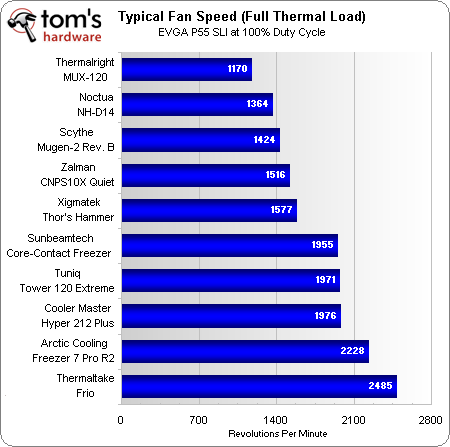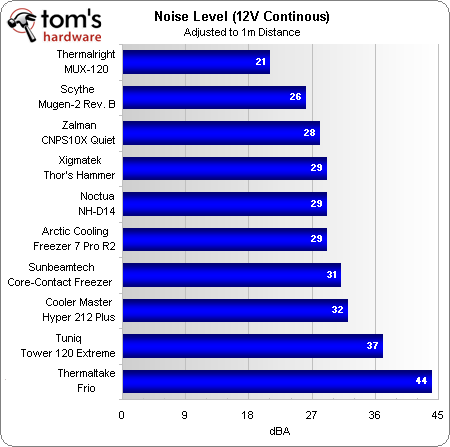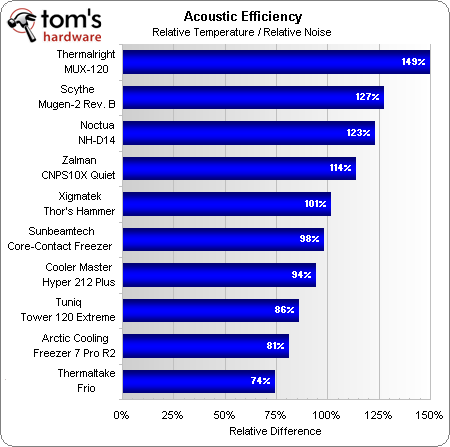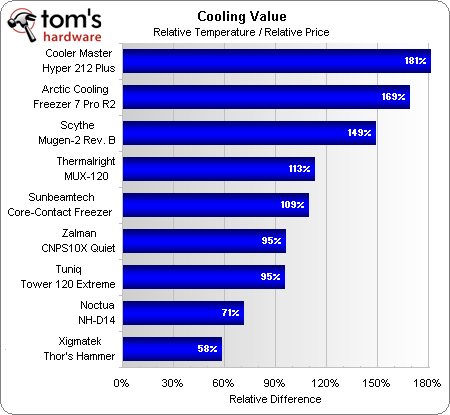Overclocking On Air: 10 LGA 1156-Compatible Performance Coolers
Fan Speed, Noise, And Value
Why you can trust Tom's Hardware
Fan speed is the biggest factor in both noise levels and airflow, two things that manufacturers must carefully consider before launching any new cooling product. One might thus expect the noisiest cooler to be the most powerful, although sink design is often more important.

Thermalright’s moderate cooling performance is achieved with a surprisingly low-speed fan, while Thermaltake’s Frio spins over twice as fast at maximum speed. Potentiometers on the Frio’s fans allow these to be slowed, but it would have been impossible test the infinite number of available settings.

Running at slightly less than its rated speed, our Thermalright MUX-120 sample also produced slightly less noise than its rated maximum. Scythe’s second-place quietness is impressive in light of its second-place cooling performance.
The easiest way to figure out which cooler provides the best cooling-to-noise ratio is to convert each observation to a percentage, relative to other coolers in the test. We divided the average temperature produced by all coolers by the actual temperature produced by each cooler to create a temperature-percent scale. A separate noise-percent scale divides each cooler’s SPL by the average noise of all coolers. Dividing each cooler’s temperature ranking by its noise ranking allows a number to be assigned to its acoustic efficiency, aka "cooling-to-noise ratio.”

Thermalright’s supremely quiet fan and mid-pack cooling performance team up to give the MUX-120 a first place cooling-to-noise finish. Scythe’s mid-speed fan and huge sink allow its Mugen-2 Rev. B to retain second place.
Applying the same calculation method used above to temperature and price allows value to be assessed numerically.

The above chart comes with a big caveat: while Cooler Master’s Hyper 212 Plus provided enough cooling for our 4 GHz CPU, the Freezer 7 Pro Rev.2 did not. Thus, while Cooler Master’s low $30 price makes it a great deal for ambitious overclockers, the Freezer 7 Pro Rev.2 is better suited for less enthusiastic tweakers.
Current page: Fan Speed, Noise, And Value
Prev Page Thermal Testing Results Next Page Do We Have A Winner?Stay On the Cutting Edge: Get the Tom's Hardware Newsletter
Get Tom's Hardware's best news and in-depth reviews, straight to your inbox.
-
kumaiti Not a single top down cooler?? That is disappointing, though I can already see the excuse: "they don't have as much performance as the tower coolers".Reply -
mrgrey Argh - unbelievable! I literally just purchased my build on newegg, and they just posted this article. I bought the Arctic Cooling 7 over the Hyper 212+, not having seen the article yet.Reply
Hey Tom's - what temps are you getting at 3.2 GHz with the Arctic Cooling 7? Did you use arctic silver 5? -
barmaley Test settings page reads: CPU Intel Core i7-860, but CPU-Z screen shot under it reads Intel Core i7-870. Which one is it that you tested Tom?Reply -
nzprogamer mrgreyArgh - unbelievable! I literally just purchased my build on newegg, and they just posted this article. I bought the Arctic Cooling 7 over the Hyper 212+, not having seen the article yet. Hey Tom's - what temps are you getting at 3.2 GHz with the Arctic Cooling 7? Did you use arctic silver 5?Reply
no worries there you will be fine -
nzprogamer i had the 212 and sunbermtech both were running really good and cool. but i would buy the sunbeamtech with the easy exchange fan kit.Reply -
Crashman kumaitiNot a single top down cooler?? That is disappointing, though I can already see the excuse: "they don't have as much performance as the tower coolers".falchardWhat no Coolermaster V10 or Thermaltake SpinQ Vertical?You would have to ask the manufacturers, since they picked the coolers.Reply
